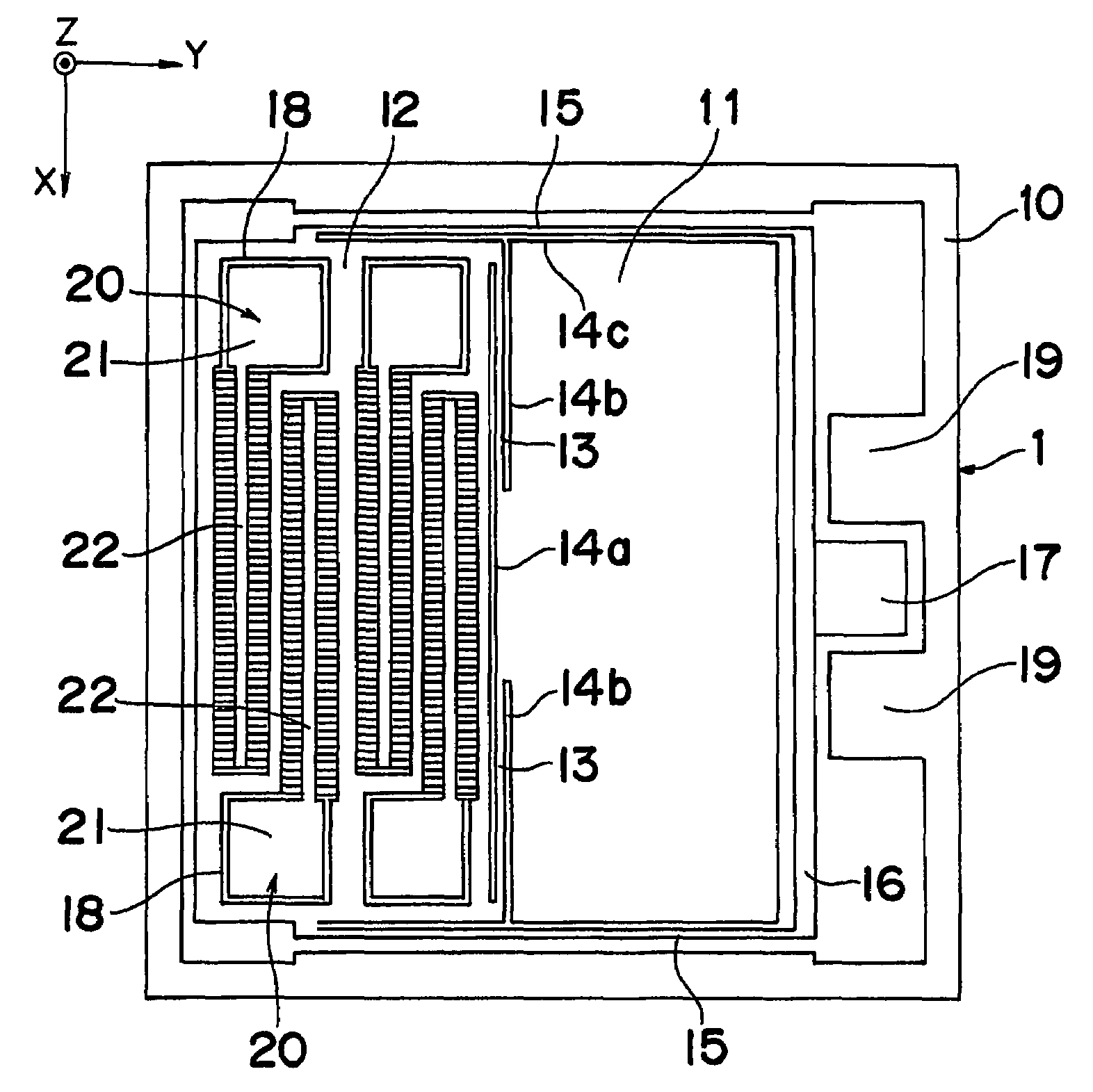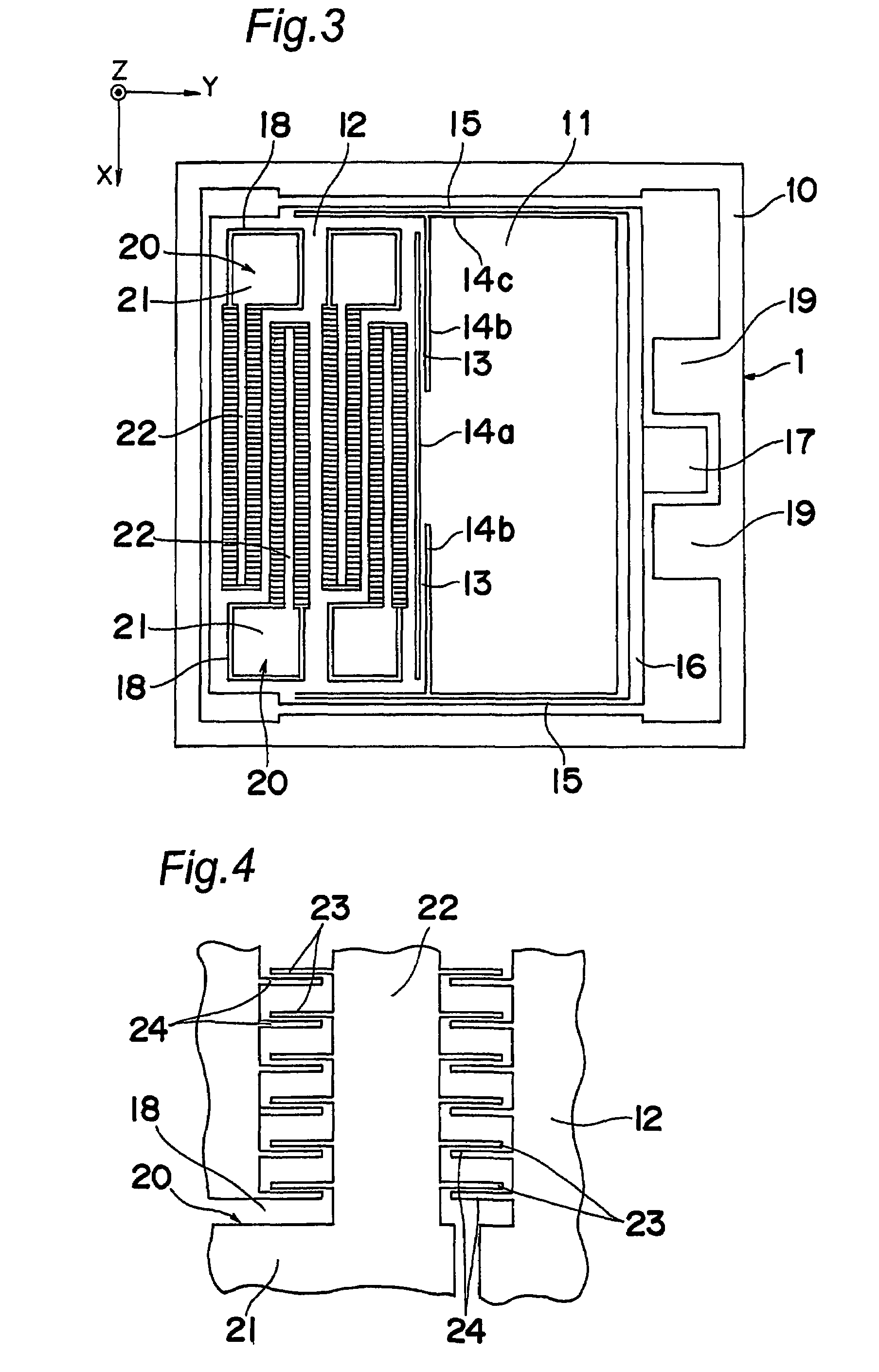Gyro sensor and sensor apparatus using same
a sensor and gyro technology, applied in the field of gyro sensors, can solve the problems of large variable detection value, and achieve the effects of reducing temperature dependence of detection value, reducing sensitivity to angular velocity, and less susceptibl
- Summary
- Abstract
- Description
- Claims
- Application Information
AI Technical Summary
Benefits of technology
Problems solved by technology
Method used
Image
Examples
first embodiment
[0101]As shown in FIGS. 1 and 2, a gyro sensor according to a first embodiment of the present invention has a three-layer structure comprising a primary base plate 1 formed of a silicon substrate, a support base plate 2 formed of a glass substrate and superimposed on one surface of the primary base plate 1, and a cap 3 formed of a glass substrate superimposed on the other surface of the primary base plate 1. Each of the support base plate 2 and the cap 3 is joined to the primary base plate 1, for example, by an anodic bonding process. The primary base plate 1 may be made using any suitable semiconductor material other than silicon.
[0102]As shown in FIG. 3, the primary base plate 1 includes a driven mass body 11 and a detection mass body 12 which are formed in a rectangular shape in top plan view and disposed in parallel to one another along a plate surface of the primary base plate 1. The primary base plate 1 further includes a rectangular-shaped frame 10 surrounding around the driv...
second embodiment
[0121]As shown in FIG. 9, a gyro sensor A according to the second embodiment comprises a connection segment 35 separated from a frame 10, in place of the lower ground segment 19 illustrated in FIG. 3 in the gyro sensor A according to the first embodiment. A connection pad 36 is formed on a surface region of the connection segment 35 opposed to the corresponding through-hole 26. While omitted in the figures for the first embodiment, the connection pad 36 is also formed on each of the fixing segment 17, the ground segment 19 and the electrode segments 21. The through-hole 26 is formed in the support base plate 2 in each of regions thereof corresponding to the connection pads 36.
[0122]The shape of a stationary driving electrode 25 in the second embodiment will be described with reference to FIG. 12A showing a support base plate 2 in a third embodiment. The stationary driving electrode 25 in the second embodiment includes a stationary-driving-electrode pad 37 extending rightwardly (in F...
third embodiment
[0126]As shown in FIG. 12A, a gyro sensor A according to a third embodiment of the present invention comprises a support base plate 2 formed with a stress relaxation groove 38 having a strip-shaped opening elongated in the X-direction. The stress relaxation groove 38 is formed in a region of the support base plate 2 opposed to a detection mass body 12.
[0127]The stress relaxation groove 38 may penetrate through the support base plate 2 in its thickness direction as shown in FIG. 12B, or may not penetrate therethrough as shown in FIG. 12C. A technique for forming the stress relaxation groove 38 may include a reactive ion etching process, and a wet etching using hydrofluoric acid. According to the gyro sensor according to the third embodiment, even if the support base plate 2 and a primary base plate are different in thermal expansion coefficient, a thermal stress generated in the width direction of the stress relaxation groove 38 (Y-direction) is relaxed by the change in width dimensi...
PUM
 Login to View More
Login to View More Abstract
Description
Claims
Application Information
 Login to View More
Login to View More - R&D
- Intellectual Property
- Life Sciences
- Materials
- Tech Scout
- Unparalleled Data Quality
- Higher Quality Content
- 60% Fewer Hallucinations
Browse by: Latest US Patents, China's latest patents, Technical Efficacy Thesaurus, Application Domain, Technology Topic, Popular Technical Reports.
© 2025 PatSnap. All rights reserved.Legal|Privacy policy|Modern Slavery Act Transparency Statement|Sitemap|About US| Contact US: help@patsnap.com



